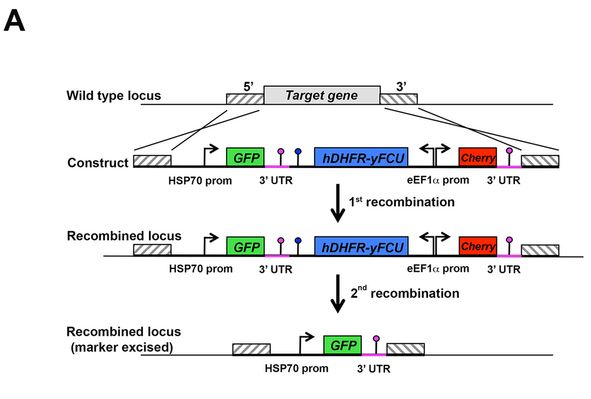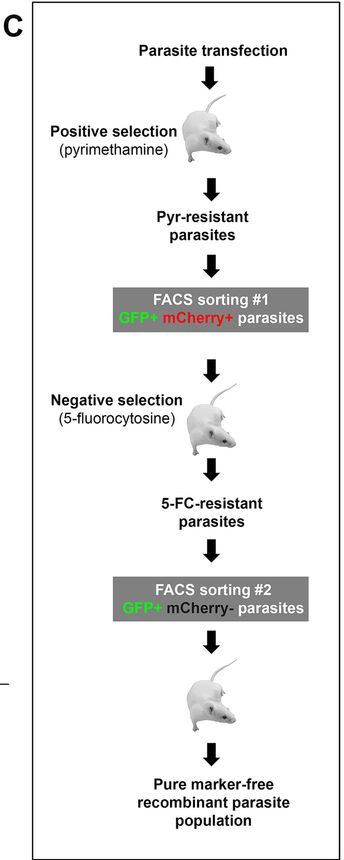SummaryRMgm-1026
|
||||||||
 *RMgm-1026
*RMgm-1026| Successful modification | The parasite was generated by the genetic modification |
| The mutant contains the following genetic modification(s) | Introduction of a transgene |
| Reference (PubMed-PMID number) |
Reference 1 (PMID number) : 24755823 |
| MR4 number | |
| top of page | |
| Parent parasite used to introduce the genetic modification | |
| Rodent Malaria Parasite | P. berghei |
| Parent strain/line | P. berghei ANKA |
| Name parent line/clone | P. berghei ANKA cl15cy1 |
| Other information parent line | A reference wild type clone from the ANKA strain of P. berghei (PubMed: PMID: 17406255). |
| top of page | |
| The mutant parasite was generated by | |
| Name PI/Researcher | Manzoni G; Silvie O |
| Name Group/Department | INSERM |
| Name Institute | INSERM |
| City | Paris |
| Country | France |
| top of page | |
| Name of the mutant parasite | |
| RMgm number | RMgm-1026 |
| Principal name | Δp230p-GFP |
| Alternative name | |
| Standardized name | |
| Is the mutant parasite cloned after genetic modification | Yes |
| top of page | |
| Phenotype | |
| Asexual blood stage | GFP expression in blood stages |
| Gametocyte/Gamete | Not tested |
| Fertilization and ookinete | Not tested |
| Oocyst | Not tested |
| Sporozoite | Not tested |
| Liver stage | Not tested |
| Additional remarks phenotype | Mutant/mutation The construct (see Fig. A below) used contains i) GFP under control of the constitutive promoter of PbHSP70 and ii) a hDHFR-yFCU fusion gene, for positive negative selection, coupled to a second fluorescent cassette, encoding the red fluorescent protein mCherry. Both hDHFR-yFCU and mCherry are placed under control of a single bidirectional promoter of PbeEF1a (PBANKA_113330 and PBANKA_113340). The GFP and mCherry reporter genes are followed by an identical 1 kb fragment corresponding to the 3' untranslated region (UTR) of P. berghei DHFR-TS, placed in the same orientation, which serves both as a transcription terminator, for proper expression of the reporters, and for recycling of the drug resistance cassette. Spontaneous recombination between the two homologous PbDHFR-TS 3' UTR fragments results in excision of both the hDHFR-yFCU and the mCherry expression cassettes Therefore, with this strategy, parasites that have excised the drug-selectable marker become GFP+mCherry-, and can be easily distinguished from GFP+mCherry+ parasites still harbouring the hDHFR-yFCU marker. Selection procedure (see Fig. C below): This new selection method eliminates the need for in vivo cloning of the parasites, and allows the rapid generation of drug-selectable marker-free P. berghei and P. yoelii mutants expressing a GFP or GFP-LUC cassette, using as few as three mice.
Other mutants |
 Transgene: Mutant parasite expressing a transgene
Transgene: Mutant parasite expressing a transgene| top of page | |||||||||||||||||||
| Type and details of transgene | |||||||||||||||||||
| Is the transgene Plasmodium derived | Transgene: not Plasmodium | ||||||||||||||||||
| Transgene name | GFP | ||||||||||||||||||
| top of page | |||||||||||||||||||
| Details of the genetic modification | |||||||||||||||||||
| Inducable system used | No | ||||||||||||||||||
| Additional remarks inducable system | |||||||||||||||||||
| Type of plasmid/construct | Plasmid double cross-over | ||||||||||||||||||
| PlasmoGEM (Sanger) construct/vector used | No | ||||||||||||||||||
| Modified PlasmoGEM construct/vector used | No | ||||||||||||||||||
| Plasmid/construct map | |||||||||||||||||||
| Plasmid/construct sequence | |||||||||||||||||||
| Restriction sites to linearize plasmid | |||||||||||||||||||
| Selectable marker used to select the mutant parasite | hdhfr/yfcu | ||||||||||||||||||
| Promoter of the selectable marker | eef1a | ||||||||||||||||||
| Selection (positive) procedure | pyrimethamine | ||||||||||||||||||
| Selection (negative) procedure | 5-fluorocytosine (5-FC) | ||||||||||||||||||
| Additional remarks genetic modification | |||||||||||||||||||
| Additional remarks selection procedure | The parasites are selected by a combination of positive selection (pyrimethamine), negative selection (5-FC) and FACS sorting. 1) Transfected parasites are first selected in a mouse by pyrimethamine treatment 2) GFP+mCherry+ parasites are selected by FACS sorting and used to infect a mice 3) This mouse is treated with 5-FC to select for parasites that have the selectable marker removed 4) GFP+mCherry- and marker free parasites are selected by FAC sorting and used to infect a mouse | ||||||||||||||||||
| top of page | |||||||||||||||||||
| Other details transgene | |||||||||||||||||||
| top of page | |||||||||||||||||||
| Promoter | |||||||||||||||||||
| Gene Model of Parasite | PBANKA_0711900 | ||||||||||||||||||
| Gene Model P. falciparum ortholog | PF3D7_0818900 | ||||||||||||||||||
| Gene product | heat shock protein 70 | ||||||||||||||||||
| Gene product: Alternative name | HSP70 | ||||||||||||||||||
| |||||||||||||||||||
| top of page | |||||||||||||||||||
| 3'-UTR | |||||||||||||||||||
| Gene Model of Parasite | PBANKA_0719300 | ||||||||||||||||||
| Gene product | bifunctional dihydrofolate reductase-thymidylate synthase, putative | ||||||||||||||||||
| Gene product: Alternative name | dhfr/ts | ||||||||||||||||||
| |||||||||||||||||||
| Insertion/Replacement locus | |||||||||||||||||||
| Replacement / Insertion | Replacement locus | ||||||||||||||||||
| Gene Model of Parasite | PBANKA_0306000 | ||||||||||||||||||
| Gene product | 6-cysteine protein | ||||||||||||||||||
| Gene product: Alternative name | P230p | ||||||||||||||||||
| |||||||||||||||||||
| top of page | |||||||||||||||||||




